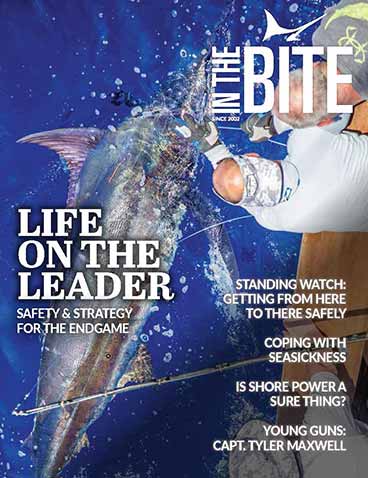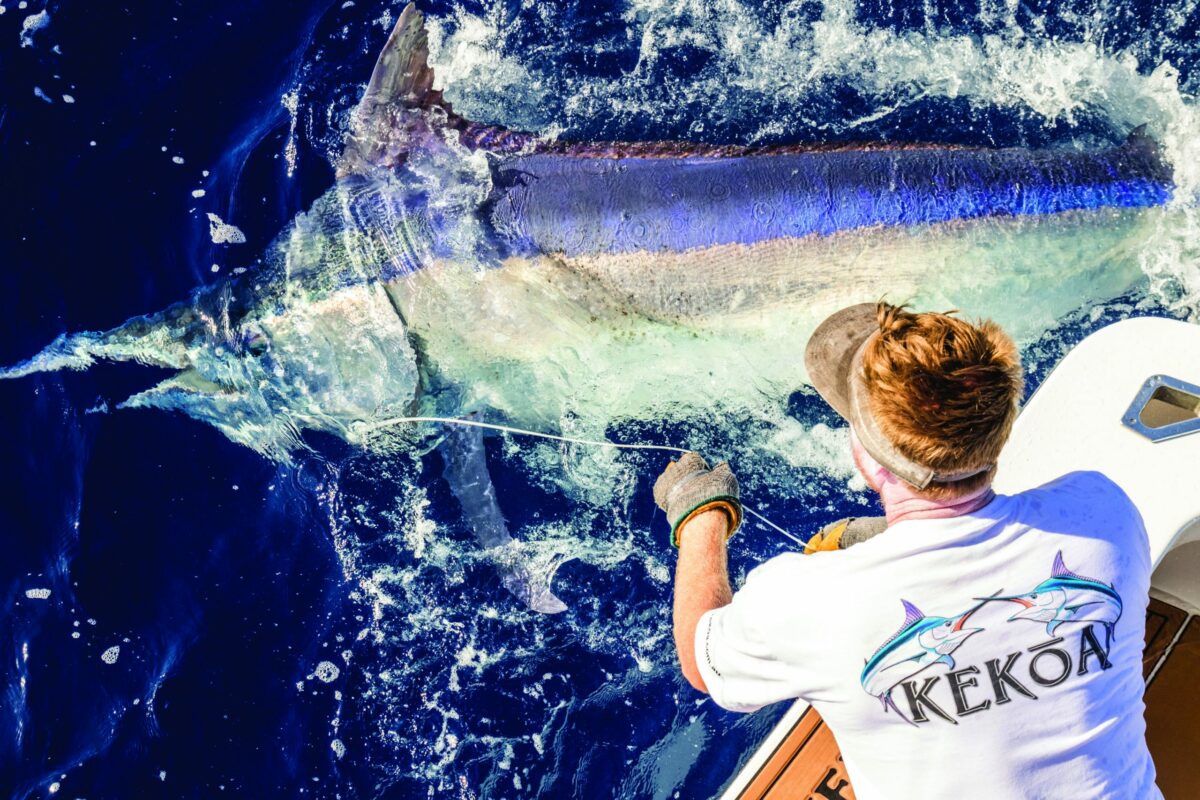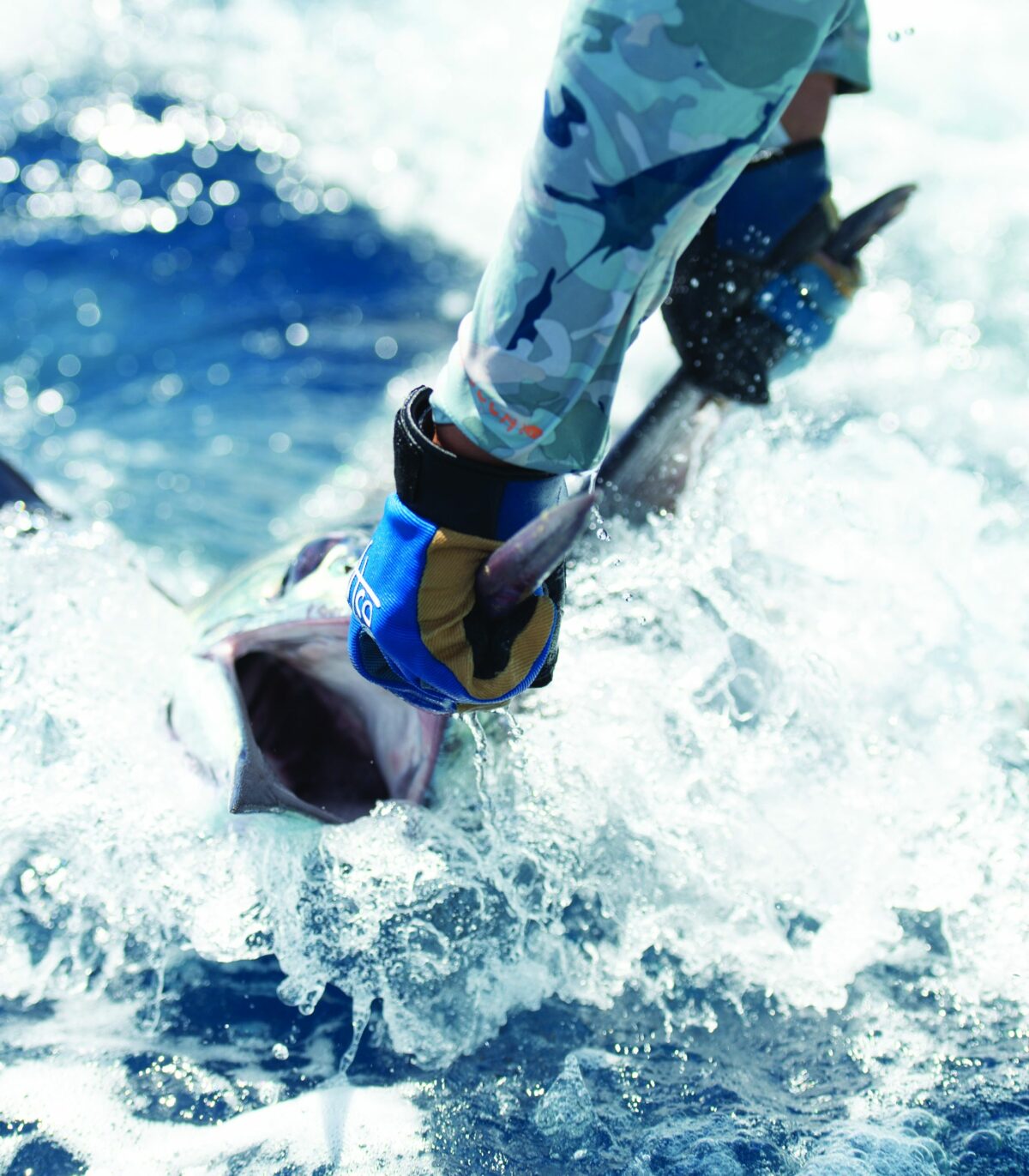. You can be releasing 35-pound sailfish one day and get the call to go to Bermuda the next. Even for those with a wealth of experience, leadering big fish on heavy leader can be a dangerous proposition. Before tangling with a sea monster, there are a few things you should know. To teach these skills, there are few better instructors in the world than Jarad Dingo Boshammer. Dingo provides an expert education in leadering big fish and the approaches he uses for releasing, tagging and gaffing them. If you ever plan to encounter big fish, this is a must-read. Whether it be tournaments, record fishing or straight up fishing for fun, sportfishing is a team sport. When all goes according to plan and the time comes for the end game, the wireman job begins. The approach and techniques best applied to the leader depend on the species, tackle, and line class. The approach also depends on the goal of the encounter”whether a release, tag or gaff shot is the end game.
A Wireman Supplies
Sunglasses are a must before engaging in any sort of leadering! I dont care how much saltwater is on my glasses, they never come off when Im on the leader. A couple guys I know have had a glass lens shatter, leaving shards of glass in their eyes. For this reason, I prefer polycarbonate. Footwear is also important. While you might get by without it for sailfish on light leaders (it is still a good idea), when it comes to gaffing fish on heavy leaders it is 100% necessary. Another necessity is a tool belt. At the bare minimum, youll need a release knife. You should never cut one off with an open blade”one head shake or wave and the result can be messy (slashed arms or thighs have happened). I always have an open bladed knife on my belt it could turn into a backup release knife in an emergency only. Having two mates is always ideal and coaching each other is important. Regardless of skill level, I will always ask the other mate to carry the release knife in the center of their back. It is crucial that a release tool may be reached with either hand when you are on the leader.

Nine-hundred pound leader exploding on a going away jump from a 700-pounder with a straight arm. Photo courtesy Kelly Dalling Fallon
The boat impact on leadering technique
My style of leadering will change depending on the boat. Most Aussie boats are in the 40-50-foot range. Australian boats have a minimum gunnel height that is required for surveyed vessels. The height minimum is relatively high. My knees generally fit below the covering board and touch the sides of the hull easily. Thighs should be placed against and below the gunnels for added security and leverage. This is the ideal situation for doing serious work. When boats get bigger with wider covering boards I cant find the hull side effectively. Without a hard surface for my knees, I am much more reliant on footwork for leverage. The sleek design of most modern boats causes the covering boards to hit right on, or slightly above, the ball of the knee. This allows for a solid contact but leaves nothing for you to tuck under and press your thighs against. In the event of a bad wrap, swallow your pride and let everyone know. Once that done, tuck in deep. Even 550-pound leader will usually break before anything serious happens if you get deep, below the gunnels and lock on. For this reason, it important to know your boat and cockpit well. It also important to know your tackle. Know the limits of every crimp, knot and connection. Crimpers should be dialed in and every connection broken on a line testing machine. When gear is being pushed to the limits, it pays to have confidence and know your gear inside out.

Second hand over the one with wraps to stall out a 900 black marlin on Capt. Luke Fallon Kekoa. Photo courtesy Kelly Dalling Fallon
Boat Handling
In the event that a fish goes under, a drastic decision needs to be made. In some cases, it is better to hang on rather than to dump. If your leader is much heavier than the main line, it could be better to have the stronger of the two make contact with the boat. If the fish makes a sprint, goes under the boat and you dump, the captain needs to use the outside engine in reverse and throw the wheel to the fish. Trying to drive forward out of this situation will run the main line over almost every time. It is crucial to reverse and spin away from the main line and leader putting the fish of your bow.
Fish Behavior: The effect of the fight on your approach
Paying attention to the fish during a fight is very important. The behavior can give an idea of hook placement or lack thereof. Taking photos of jumping fish can also help. When zooming in and seeing good hook placement, my confidence and the drag both go up. What signs in a fight tell you to be careful? A couple indicators are radical head shakes or abnormal behavior. These could be signs of a hootered fish or where the hook point has hit a sensitive bony position at the base of the bill. In this case your best option is light drag, staying behind the fish and using gentle hands on the leader. Try to stay low; dont encourage the fish to jump. A fish that has done nothing at all is another concern, especially on bait. This often means the hook has not found a home and it is only a matter of time before the fish will gag out the bait. In this case, stay behind the fish, use light drag, be gentle on the leader and pray the fish does all the wrong things.

Using a second hand over the one with wraps is great for lifting a fish down digging and also stalling out a going away jump. Photo courtesy Kelly Dalling Fallon
Heavy leader, big fish
Pulling hard on leader is a blast making fish jump and do crazy stuff is what I love. This, however, is not always the right practice. When getting close enough for a photo release, tag or kill shot during a tournament, the ability to take the leader smoothly and take wraps without the fish noticing is a great skill to have. On heavy leader with big fish, the back wrap is a must-have in your arsenal. When taking a back wrap, you would start by pulling the leader down with one hand and wrapping with the other. The hand taking a back wrap will be thumb down, with the leader hitting the outside of your hand (nearest your pinky finger).
When the leader breaks over the outside of your hand, take it with all four fingers and rotate your hand until your thumb is on top. With the other hand bring the leader between your thumb and forefinger. This completes the first wrap and then the standard technique is required for the second wrap. This technique allows you to make your first wrap (instead of taking it against the pressure of the fish). The back wrap technique is very well known by any heavy tackle expert especially when large marlin or giant bluefin tuna are involved.
Standard wraps are taken after you pull the leader down with one hand with the other palm up and thumb out. The leader should hit between thumb and forefinger first. Start taking your hand up and then rotate outwards, bringing it down in a circular motion.
 Try not to take large windmill-like wraps, focusing rather on tight wraps with equal pressure. Take a second wrap on the same hand as soon as possible. If the fish is digging, use your spare hand over the one with wraps and pull with two hands. Then use the spare hand to do the same thing.
Taking wraps, however, is not always the first move. If the fish is up high and youre backing down fast, the best thing to do is hand-over-hand, anticipating when the weight will come. Take your first set of wraps when the time is right. Often that time is when the boat is slowed down or when you are already close enough to the fish.
When preparing for wraps, keep your arms bent with your hands low and close to your body. This will provide a shock absorber, buffering against leaders breaking, hooks pulling or getting straightened. If the fish jumps on the leader, youll have a little give and might not need to dump the line. There is nothing worse than dumping a fish and the double line not even leaving the rod tip. That being said, hanging onto smaller fish too long and flipping them over is very dangerous.
Try not to take large windmill-like wraps, focusing rather on tight wraps with equal pressure. Take a second wrap on the same hand as soon as possible. If the fish is digging, use your spare hand over the one with wraps and pull with two hands. Then use the spare hand to do the same thing.
Taking wraps, however, is not always the first move. If the fish is up high and youre backing down fast, the best thing to do is hand-over-hand, anticipating when the weight will come. Take your first set of wraps when the time is right. Often that time is when the boat is slowed down or when you are already close enough to the fish.
When preparing for wraps, keep your arms bent with your hands low and close to your body. This will provide a shock absorber, buffering against leaders breaking, hooks pulling or getting straightened. If the fish jumps on the leader, youll have a little give and might not need to dump the line. There is nothing worse than dumping a fish and the double line not even leaving the rod tip. That being said, hanging onto smaller fish too long and flipping them over is very dangerous.

Turning hats backwards on the leader is not a fashion statement, the brim of a baseball cap gets in the way when switching sides of the leader. I use two no. 64 rubber bands around the wrist of my gloves for snug fit, low profile, and to help keep my gloves on. Photo courtesy Kelly Dalling Fallon
The Angler
Anglers should back off the drag on heavy tackle as soon as you have wraps. If you have to dump the leader and the drag is up high, the pressure on the reel will go from nothing to a lot in a split second. This can reef anglers out of the chair or turn them into frogs with knees behind their ears. With wind-on leaders, the most common mistake is cranking a mate hand up and trapping wraps on the glove. The lighter drag, in this case, will enable the wireman to pull his hand down to a comfortable and safe height. Be careful, however, not to backlash the reel when doing so.

When giants get line shy and 200-pound fluoro is the largest leader that produces bites, the wire man job becomes very delicate. The wireman best approach involves working with the angler, applying a bit of pressure with the hand over hand technique and keeping the fish head. Once you are boat-side, break the fish head and take a set of wraps. As hard as it is not to take wraps all the way, that is often not the right approach. Photo courtesy Russell Kleppinger
The Kill Shot
Securing a trophy fish with gaffis one of the most challenging in most events in sportfishing. When preparing to harvest a fish, safety comes first” no matter what. No matter how big the fish may be or how much money is on the line, it isnt worth losing an eyeball or joining the underwater wireman club. Accidents can happen to anyone and we all must have respect for the fish and the ocean. When it comes to getting hurt (or worse), the first saying I was taught was, There are those who have and there are those who have not, yet.













